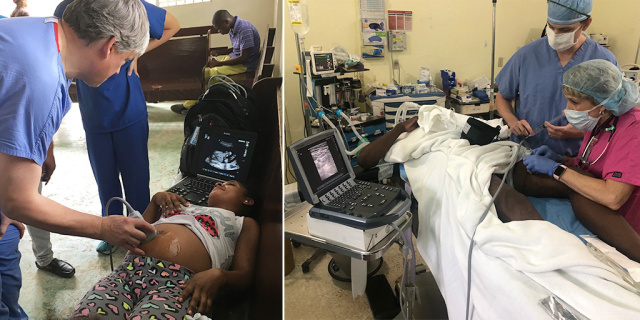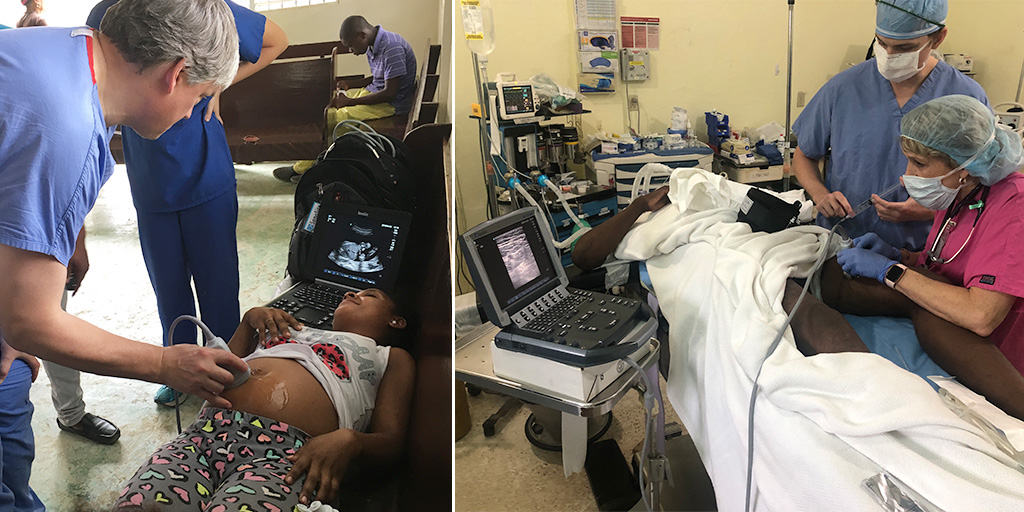
Dr. David Johnsen is a diagnostic radiologist working with medical missions to the Dominican Republic. His team borrowed a Sonosite M-Turbo through Sonosite’s Global Loaner Program for a recent mission. Dr. Johnsen submitted this report of his experiences in the Caribbean country.
Our medical mission team is organized through Second Presbyterian Church in Roanoke, Virginia. We are one of about 30 medical teams that participate in the mission of Solid Rock International (SRI). SRI is a nonprofit Christian ministry that operates in the Dominican Republic (DR), based in San Juan de la Maguana, in the middle part of the country two hours west of Santa Domingo and an hour east of the Haiti border. The mission of SRI is “transforming the body, mind, and soul of the poor in the Dominican Republic.” SRI sponsors a clinic in San Juan and is building a new hospital there. They also sponsor a child nutrition program and five schools.
International travel to non-tourist destinations is often an adventure. Our team travels together to Santa Domingo and is greeted by in-country SRI staffers who transport the team to San Juan. Getting through customs with 70 to 80 bags of surgical equipment and pharmacy supplies usually goes well, but occasionally there are delays due to inspections. The two-hour bus ride from Santa Domingo to San Juan has gotten considerably better in the past few years now that the roads are paved, but travel to the barrios (rural villages) is often over deeply rutted dirt roads traversed by mopeds going in all directions with a variety of chicken, pigs, and mules.

Serving Remote Communities
I am a diagnostic radiologist, but my role for this medical mission is quite varied. I currently serve as the trip coordinator and as a doctor on the mission team. I perform perioperative ultrasound exams as requested by my surgery colleagues, and I perform diagnostic ultrasound studies in the villages that our barrio family medical team visits. I also assist in the OR if a surgeon needs a helper, and I make occasional house calls for patients in the villages that are too sick or too weak to come to the barrio clinic site.
Our particular group has gone on 19 consecutive annual trips staffed by doctors, nurses, a pharmacy team, and a construction team that helps out at the new hospital construction site. On the medical side, we typically have a surgical team with general surgeons, orthopedic surgeons, and a family practice team that travels to small rural communities for daily clinics. The surgical patients are identified by the SRI clinic staff doctors and also by prior visiting medical teams. The barrio clinics are set up by the SRI clinic coordinator who prearranges visits to many of the medically-underserved rural communities in western DR.
Many of the patients we see in the remote barrios only get medical attention when you go to them. In some of the villages, you leave the bus on the main road and sometimes hike up a hillside to see patients that can’t make it to the temporary clinic site, typically in a church or school building. The clinic is usually an open air room where we set up four or five patient stations and a portable pharmacy. The patients are triaged by nurses and then directed to one of the table stations, where they are seen by a physician or nurse practitioner.
Flexibility is Key
The operative word in this type of medical care delivery is flexibility. Whether it is in the OR (which is very primitive by U.S. standards) or in the barrios, you never know what you are going to encounter, and you often need to be creative in your approach to treatment. On our last visit in February 2020, we were unable to get an OR drill needed to remove infected hardware in a woman’s femur. We improvised by carefully cleaning a battery-powered drill from the construction site and placing it in a sterile bag, autoclaving the bits. One of the SRI staff removed the wooden handle of a hammer and welded a piece of rebar to the hammerhead so that the hammer could be autoclaved.
Ultrasound an Invaluable Tool
The Sonosite M-Turbo you lent us is invaluable in our medical work. It produces high-quality images. We use the curved array 3-5 MHz transducer for RUQ (right-upper quadrant) ultrasound exams (mostly gallbladder and liver) and pelvis (mostly OB/GYN imaging). We use the linear 7-10 MHz transducer for small parts imaging, including thyroid, breast, scrotal exams, nerve block guidance, and subcutaneous foreign body location. The device is completely contained in a compact backpack, so it is easily transported. We use it daily for anesthesia nerve blocks for orthopedic cases, and I take it to the field trips in the barrios for whatever needs imaging—typically breast, abdomen, and OB/GYN studies.
While FUJIFILM Sonosite, Inc. supports the improvement of health care in the global community, we do not officially endorse any of the charities and organizations that are mentioned or linked to on our Global Health page.

